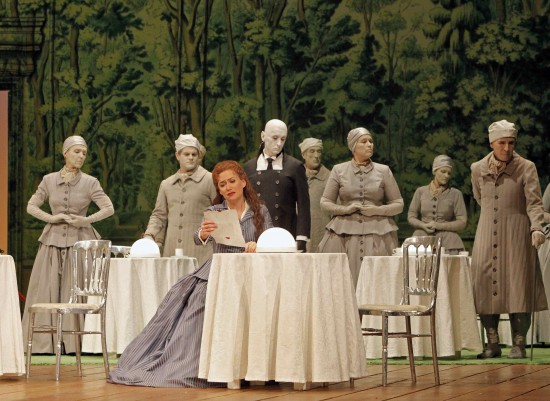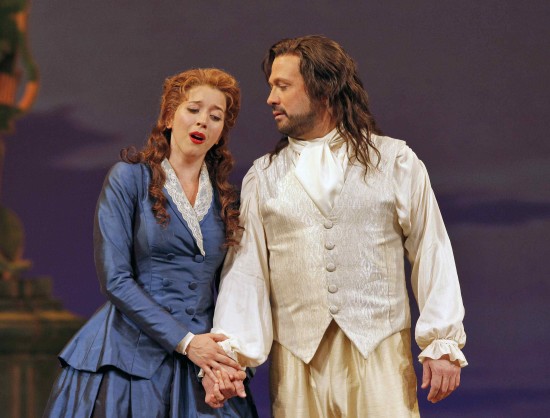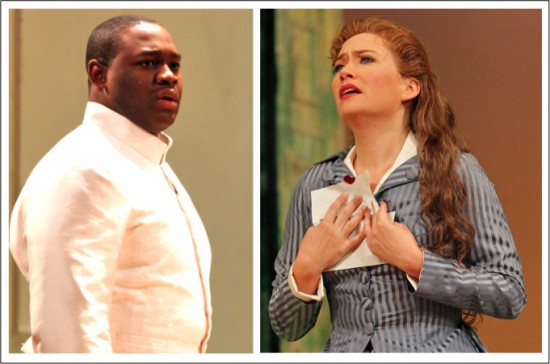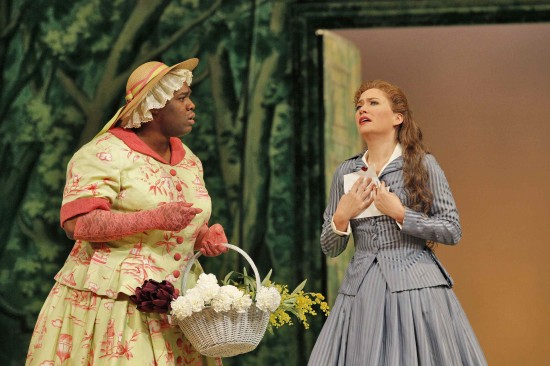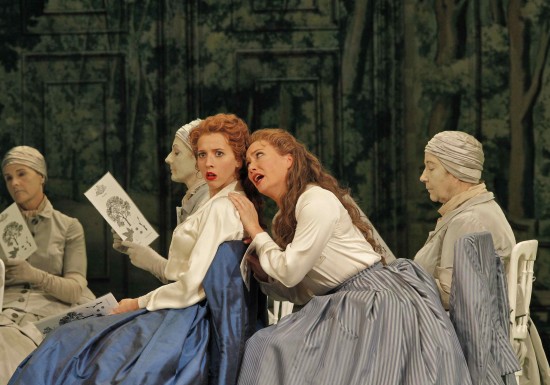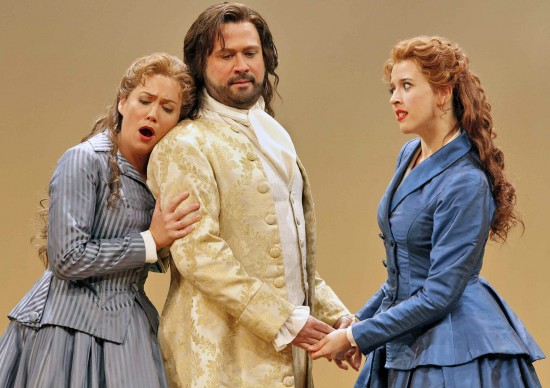George Frideric Handel¬†wrote lots of truly inspired music including more than 40 operas.¬† He visualized complex characters and put them into interesting situations.¬† But when he came up with names for these characters, he had trouble getting as far as “B” in the alphabet.¬† There are 7 characters in his¬†Xerxes, and four of them have names that begin with “A”, none of them common in today’s English-speaking world.¬† It takes a while to properly match up Amastris, Ariodates, Arsamenes, and Atalanta with Xerxes’ beloved, brother, fianc…e, and general.
Costume Supervisor¬†¬†Christopher Verdosci¬†didn’t make it any easier to keep¬† track of who’s who by making the outfits of Xerxes and his brother look very much alike.¬† Granted that from up close it’s easy tell the difference between¬†Susan Graham¬†as Xerxes and¬†David Daniels¬†as Arsamenes (for one thing,¬†Daniels has a beard), the back half of the audience can’t see enough detail to be sure.
Then, there’s the question of gender identification.¬† There are 7 named roles: four males and three females.¬† There are 7 singers: three males and four females.¬† There are 5 voices mezzo and higher – two voices baritone or lower.¬† Got that all straight?
It took me most of Act I, but you can be smarter than I and catch on sooner.  Shortly after the overture began the main curtain went up revealing a fore-stage with a plain green curtain behind it, and a large number of people, in simple period costumes all in exactly the same dull gray-brown color with faces to match walked slowly on stage, turned 90 degrees to face the audience, bowed, turned another 90 degrees, and walked off.  Next, a group of about 6 or 8 men dressed in black walked on, repeated the sequence of turns  and bows, and walked off.  Finally, one by one, 7 people dressed in various costumes did the same.
I did not notice until it was too late that the super-title screen was displaying the name of the group or character taking the bow.  So I had to figure them out as the action proceeded.  The beige people were the chorus and supernumeraries of courtiers, wardens, generals, and guards.  The men dressed in black were stagehands and waiters.
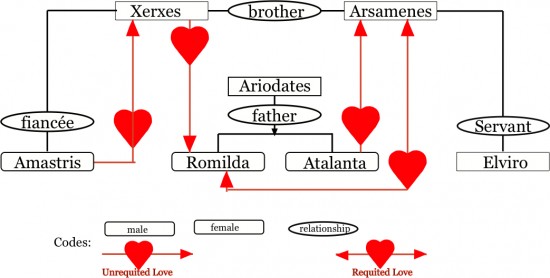
Relationships: Family in Black; Love in Red; chart by Philip Hodge (use of red hearts and arrows suggested by chart in printed program)
Here’s a chart to help you follow the family relations and the emotional relationships between the 7 characters.¬† As you can see, Romilda (Lisette Oropesa) and Arsamenes (David Daniels) are mutually in love; Arsamenes is also the unwilling recipient of Atalanta’s (Heidi Stober) love; and despite the fact that Xerxes (Susan Graham) is engaged to Amastris (Sonia Prina) who adores him, he is infatuated with Romilda.¬† The only two characters not bitten by the love bug are Ariodates (Wayne Tiggs), father of Romilda and Atalanta, and Elviro (Michael Sumuel), servant to Arsamenes.
That’s where we start near the beginning of Act I, and it all gets resolved in the finale to Act III.¬† Romilda and Arsamenes are happily embracing in the center of the stage.

Over on the right side, Xerxes has seen the error of his ways and asked Amastris to forgive and forget (I wonder how long that will last).¬† She’s forgiven him but is in no hurry to let him know – let him suffer.
Which leaves Elviro and Atalanta on the left side.¬† They look at each other with some wonderfully expressive gestures and responses which seem to say, “Well, you’re not my first choice, but you’re what’s left – what say we try to make a go of it?”
And standing a little apart is Papa Ariodates, feeling very pleased with himself – and why shouldn’t he?¬† One daughter married to a prince; and if the other son-in-law may be a step down socially, at least that troublesome Atalanta is off his hands.
In between, for most of the 3¬ĺ hours of the performance we hear lots of beautiful music and enjoy some first-rate acting, much of it comic.¬† Tops along that line is the scene at the beginning of Act II where Elviro has disguised himself as a female flower-seller and sings in a falsetto voice.
Heidi Stober¬†won my heart as Susanna in last year’s¬†Marriage of Figaro, and her Atalanta was a delight to watch and listen to.¬† She had a couple of great scenes with¬†Lisette Oropesa¬†with both of them moving all over the stage.¬† You didn’t have to read the super-titles to know that those two sisters were mad at each other!
Handel wrote the parts of Xerxes and his brother to be played by castrati who were a respected musical class in 18th century Europe but are now essentially extinct due to changing mores and natural selection.   Here Xerxes is sung by mezzo Susan Graham who has thoroughly mastered the art of the trouser role,
and Arsamenes by counter-tenor David Daniels, the modern equivalent (musically, that is) of a castrato.
Amastris, the other young “male”, is really of course a princess who has adopted a man’s disguise to scout out the land and find out why Xerxes is ignoring their engagement, so it is entirely natural that she is sung by mezzo¬†Sonia Prina.
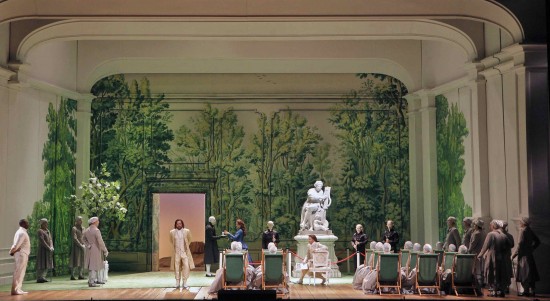
Standing (L to R) Elviro, Arsamenes, Romilda, and (seated) Xerxes; with 4 Waiters and numerous members of the Court
All in all, it was a most satisfactory evening – well sung beautiful music, fantastic sets, and great acting.¬† And the good news, if you’re reading this commentary in timely fashion, is that there are still a couple of performances to go.¬† You can still see it on either Wednesday, November 16 at 7:00 pm, or Saturday, November 19 at 7:30.
The Opera Nut
San Francisco Opera
301 Van Ness Avenue
San Francisco, CA 94102
(415) 861-4008
sfopera.com
Xerxes by George Frideric Handel
Anonymous revision of¬†Silvio Stampiglia’s libretto¬†Il Xerse,¬†based on¬†Nicolo Minato’s¬†Il Xerse
Sung in Italian with English super-titles
Approximate running time: 3 hours, 45 minutes including two intermissions.
All photos except for the Relations chart are by Cory Weaver, San Francisco Opera
Super-titles by Francis Rizzo
This review by Philip G Hodge appeared in sanfranciscosplash.com on November 12, 2011.


